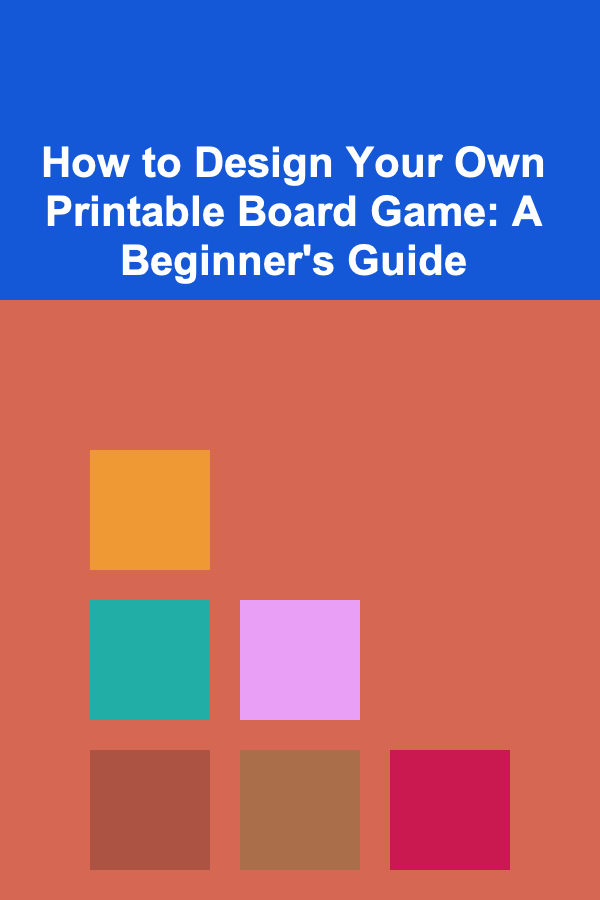
How to Design Your Own Printable Board Game: A Beginner's Guide
ebook include PDF & Audio bundle (Micro Guide)
$12.99$6.99
Limited Time Offer! Order within the next:

Designing your own printable board game can be a rewarding and creative endeavor. Whether you're a hobbyist looking to create a fun game for friends and family, or an aspiring game designer hoping to share your creation with a broader audience, the process of designing a board game from scratch can be incredibly fulfilling. With the rise of platforms like Etsy, print-on-demand services, and self-publishing tools, creating a board game has never been more accessible.
In this comprehensive guide, we'll walk you through the essential steps for designing your own printable board game. From brainstorming your concept to fine-tuning your game's mechanics, we'll cover everything you need to know to bring your idea to life. Even if you're completely new to game design, you'll find that with patience and dedication, it's entirely possible to create a game that's engaging, fun, and print-ready.
Start with a Concept
The foundation of any great board game begins with a strong concept. Your concept will set the tone and direction for the entire game, guiding everything from the game mechanics to the overall theme and artwork. The first step in creating your printable board game is to ask yourself: what kind of experience do you want players to have?
- Theme: Think about the world your game is set in. Do you want it to be a historical adventure, a fantasy quest, or a modern-day strategy game? Your theme will inform many of the design decisions you'll make later, from the artwork to the rules.
- Game Type: Consider the type of game you want to create. Do you want it to be a cooperative game, where players work together to achieve a common goal, or a competitive game, where each player vies for individual success? Alternatively, you could create a solo game or a party game for large groups.
- Target Audience: Who will be playing your game? Is it for kids, families, or a more mature audience? Tailoring the game's complexity and content to your target audience will help make it more enjoyable and engaging.
Once you've settled on a general concept, take some time to write a brief description of your game. This will serve as your vision and will help keep you focused throughout the design process.
Define the Game's Mechanics
Now that you have your concept, it's time to dive into the mechanics---the rules and systems that will govern how players interact with the game. The mechanics are the heart of your game and will determine how players experience the game. Consider the following elements when defining your game's mechanics:
- Win Conditions: How do players win the game? Are they accumulating points, completing objectives, or outlasting their opponents? Clearly define the end game and how players can achieve victory.
- Player Actions: What actions can players take on their turn? Can they move pieces, draw cards, collect resources, or attack other players? The more variety and depth you provide, the more engaging your game will be.
- Game Phases: Many games are broken down into different phases, such as setup, gameplay, and endgame. Think about how your game will flow and what each phase will look like. Will players be able to perform actions simultaneously, or will there be a strict turn order?
- Player Interaction: Consider how players will interact with one another. Will the game involve a lot of negotiation, alliances, or direct conflict? Player interaction is often key to making a game engaging and fun.
- Luck vs. Strategy: Think about how much luck will factor into your game versus strategic decision-making. For example, will dice rolls or card draws introduce randomness, or will players be able to control every aspect of the game?
Once you've fleshed out these core mechanics, write them down clearly and concisely. A game that is easy to learn and understand is essential for engaging your audience.
Design the Components
Now comes the fun part---designing the components of your game. The components are the physical pieces that players interact with, and they include things like the game board, cards, tokens, and dice. As a printable board game, these components should be easy to print and assemble at home.
- Game Board: The game board is one of the most important components of your game. Think about the layout and how players will move or interact with it. Should it be a simple grid, or will it have a more complex design, such as a map or a modular board with interchangeable tiles?
- Cards: If your game involves cards, think about the design of the cards. What will be printed on them? Will they have text, images, or both? Cards can add a lot of depth to a game, so make sure they're visually appealing and easy to read.
- Tokens/Pieces: Tokens or game pieces are essential for tracking player progress. These could be anything from simple tokens to intricate miniatures. For a printable board game, keep these components easy to cut out and assemble. You might use different shapes or colors to differentiate player pieces.
- Dice: If your game requires dice, decide how many dice and what type of dice (standard six-sided, ten-sided, etc.) will be needed. You can even design custom dice if necessary.
While designing your components, make sure they're functional and add to the gameplay experience. Consider how players will interact with these components and how the design will impact the game's overall flow.
Create a Prototype
Once you've defined your game mechanics and designed your components, it's time to create a prototype. This is a working version of your game that you can test with friends, family, or other playtesters. A prototype doesn't need to look polished---it's more important that it functions well and allows you to test the game's mechanics.
To create your prototype, you can use simple materials like paper, cardboard, and basic printouts. Here's how to put it together:
- Print and Cut Components: Print out your game board, cards, and tokens. Use scissors or a craft knife to cut them out. If you want to make the prototype more durable, you can laminate the pieces or use heavier paper.
- Assemble the Components: Put together your game board, cards, tokens, and dice. Arrange them in a way that makes sense for the flow of the game.
- Write the Rules: Create a set of rule cards or a rulebook to explain how the game works. Be as clear and concise as possible to avoid confusion during playtesting.
Once your prototype is ready, start playtesting! Gather a group of people to test your game, and pay close attention to how they interact with the game mechanics. Are there any rules that are confusing? Are some components unnecessary? Are players having fun? Use this feedback to refine the game and make necessary adjustments.
Refine the Game Based on Feedback
After playtesting, it's time to refine the game based on the feedback you received. This stage is crucial because it allows you to fine-tune the gameplay and make improvements before finalizing your game for printing.
- Rule Adjustments: Sometimes, the rules that seemed intuitive in theory may not work as well in practice. Tweak the rules to make the game smoother, more balanced, and easier to understand.
- Component Tweaks: If certain components aren't working well, consider redesigning them. Maybe the game pieces are too small, or the cards are difficult to shuffle. Small adjustments like these can significantly improve the game.
- Balance: It's important to make sure that no player has an unfair advantage. Adjust the mechanics so that players have equal opportunities to win, and that luck and strategy are balanced in a way that keeps the game engaging.
Once you've made these refinements, test the game again to ensure the changes have improved the experience.
Design the Artwork
Now that your game is taking shape, it's time to design the artwork. This is the visual element that will make your game stand out and help players immerse themselves in the world you've created. Artwork is also important for creating a cohesive theme and atmosphere for your game.
- Visual Style: Choose a visual style that complements the theme and tone of your game. For example, if your game is set in a medieval fantasy world, you might choose a rustic, hand-drawn art style. If it's a modern strategy game, a minimalist design might work better.
- Game Board Design: The design of the game board should be clear and visually appealing. Make sure the layout is easy to follow and doesn't overwhelm the player with too much information.
- Card Design: Each card should be easy to read and contain all the information players need. Consider using icons, colors, and symbols to make the cards visually appealing and functional.
- Consistency: Ensure that the artwork throughout the game is consistent. This will help create a unified aesthetic that enhances the overall experience.
If you're not an artist, consider hiring a freelance illustrator or using online design tools to create the artwork for your game. Alternatively, you could use stock images or public domain artwork to save on costs.
Prepare for Printing
Once your game design is finalized, it's time to prepare everything for printing. There are a few important considerations to keep in mind during this stage to ensure the final product looks professional and is easy to assemble.
- File Formats: Ensure that your files are in the correct format for printing. Common formats include PDF, PNG, or JPEG. Make sure the resolution is high enough to ensure clear, crisp prints (at least 300 DPI).
- File Organization: Organize all your files into a clear folder structure, separating the game board, cards, tokens, and rulebook. This will make it easier to upload and print later.
- Print-on-Demand Services: If you're planning to sell your game, consider using print-on-demand services like The Game Crafter or DriveThruCards. These platforms will print your game for you, and they also offer the option to sell your game through their websites.
Playtest Again and Finalize
Before you send your game off for printing, it's important to do one final round of playtesting. This will help you catch any lingering issues and make sure everything works as intended. Invite people who haven't played the game before to give you fresh feedback.
Once you're satisfied with the final product, it's time to prepare for release. Whether you're making it available for personal use, or you're ready to sell your game to the world, the hard work you've put into your design will pay off in the form of a fun, engaging, and professionally printed board game.
Conclusion
Designing your own printable board game is a creative process that takes patience, experimentation, and attention to detail. By following these steps---starting with a solid concept, defining mechanics, designing components, playtesting, refining, and finalizing---you can create a board game that's both fun and functional. Whether you're creating a game for friends and family or hoping to share your creation with a larger audience, the tools and resources available today make it easier than ever to bring your ideas to life. So gather your materials, put your creative hat on, and start designing your very own printable board game!
Reading More From Our Other Websites
- [Personal Care Tips 101] How to Choose a Hair Serum for Hair Growth and Strengthening
- [Personal Care Tips 101] How to Use Mouthwash to Relieve Toothaches Temporarily
- [Horseback Riding Tip 101] The Health Benefits of Horseback Riding: Fitness, Balance, and Mental Wellness
- [Scrapbooking Tip 101] Top Must-Have Tools and Apps for Creative Digital Scrapbooks
- [Hiking with Kids Tip 101] Chasing Cascades: Kid‑Friendly Waterfall Hikes Perfect for Family Adventures
- [Personal Finance Management 101] How to Track Your Spending and Cut Unnecessary Costs
- [Home Holiday Decoration 101] How to Incorporate DIY Crafts into Your Holiday Decorations
- [Personal Financial Planning 101] How to Protect Your Wealth and Avoid Financial Scams
- [Home Soundproofing 101] How to Soundproof Your Home for a Peaceful Remote Work Environment
- [Organization Tip 101] How to Use Inventory Management Software for Your Home

How to Build a Deep Learning-Based SaaS Business for Passive Income
Read More
How to Renovate Your Home to Fit Your Personal Style
Read More
How to Effectively Manage Client Communication as a Paralegal
Read More
10 Tips for Writing Engaging Historical Fiction
Read More
10 Tips for Creating Word Search Puzzles with Unique Grid Shapes
Read More
10 Tips for Negotiating the Best Deal on Your Dream Home
Read MoreOther Products

How to Build a Deep Learning-Based SaaS Business for Passive Income
Read More
How to Renovate Your Home to Fit Your Personal Style
Read More
How to Effectively Manage Client Communication as a Paralegal
Read More
10 Tips for Writing Engaging Historical Fiction
Read More
10 Tips for Creating Word Search Puzzles with Unique Grid Shapes
Read More